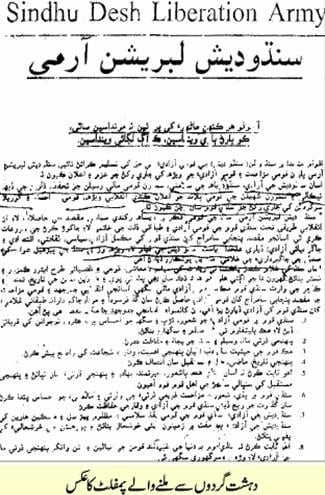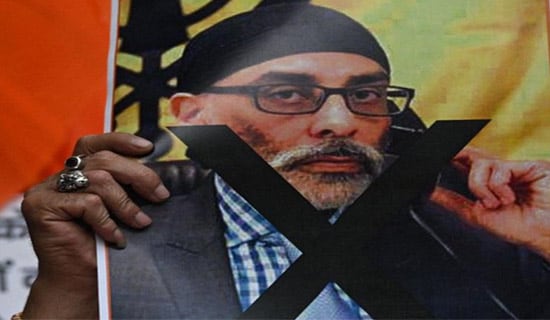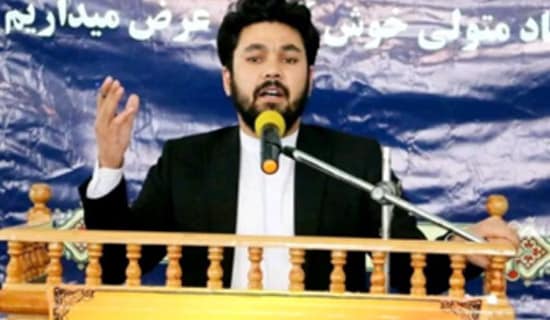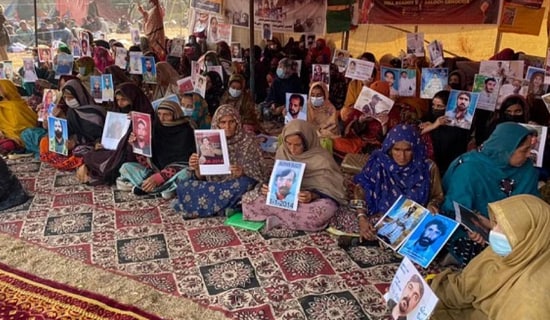
Pamphlet seized by Pakistani police from Sindhu Desh Liberation Army militants
In early March 2011, Pakistani police arrested two militants affiliated with the Jeay Sindh Muttahida Mahaz (Shafi Burfat group) from the Ibrahim Haideri locality of the Juma Goth area in Karachi, the capital of Pakistan's Sindh province. The two men, Faisal and Mubeen, were arrested after they were wounded when a bomb they were assembling detonated.[1] The explosion also led to police raids in the towns of Hyderabad, Gotki, Mehrabpur, Kotri, Nawab Shah and Karachi, and to the arrest of three more Sindhi rebels, who are accused of leading a secessionist movement for the Sindhu nation.
Sindh Province Police inspector-general Fayyaz Laghari said that the house in Karachi where the blast occurred was the headquarters of the Sindhu Desh Liberation Army (i.e. Liberation Army of the Sindhu Nation), a military wing of the Jeay Sindh Muttahida Mahaz (JSMM). The arrests led to a probe into the JSMM's links with the Research & Analysis Wing (RAW), India's external intelligence.[2] India has been traditionally accused by Pakistan of supporting secessionist groups in the Pakistani provinces of Sindh and Baluchistan.
The demand for a Sindhu nation has been raised time and again, but the secessionist movement has not posed a serious threat to the state of Pakistan. In June 2009, Syed Qaim Ali Shah, chief minister of Sindh province, brushed aside some anti-Pashtun protests in the Sindhi towns of Larkana, Hyderabad and Sukkur, arguing that only 14,000 Pashtun refugees were based in the province and calling those shouting slogans in support of Sindhu Desh (Sindhu nation) "enemies of Pakistan."[3] Last December, some Sindhu Desh Liberation Army pamphlets were found at the sites of attacks on railway tracks in Sindh province (see above).[4] Such low-scale insurgent attacks from Sindhi nationalist groups have been reported intermittently in recent years.
The Sindhi nationalist groups originated from the main organization Jeay Sindh Tehreek, founded by Sindhi nationalist leader G. M. Syed. After his death, the movement spilt into at least 11 other political and armed groups: Jeay Sindh Qaumi Mahaz (Bashir Qureshi Group): Jeay Sindh Qaumi Mahaz (Arisar Group); Jeay Sindh Mahaz (Riaz Chandio Group); Jeay Sindh Tehreek, led by Dr. Safdar Sarki; Jeay Sindh Qaumparast Party, led by Qamar Bhatti; Jeay Sindh Muttahida Mahaz, led by Shafi Muhammad Burfat; Sindh United Party, led by G. M. Syed's grandson Jalal Mehmood Shah; Jeay Sindh Maha,z led by Abdul Khaliq Junejo; Jeay Sindh Mahaz (Rasool Bux Thebo Group); Jeay Sindh Mahaz (Sufi Hazoor Bux Group); and Jeay Sindh Tahreek (Shafi Karnani Group).
After the March 2011 arrests of the militants from Karachi, the Urdu-language Pakistani daily Roznama Ummat highlighted the activities of the Sindhi militants in a report titled "Sindhu Liberation Army is being Run by RAW." Following are excerpts from the report:[5]
"Police have begun interrogating the arrested militants of the Sindhu Desh Liberation Army, the military wing of Jeay Sindh Muttahida Mahaz, regarding their contacts with the Indian secret agency RAW and their role in attacks on Pakhtuns and their properties in Karachi and entire Sindh…"
SUPPORT OUR WORK

"Police have also arrested eight other accused from the Memon Goth [area of Karachi] and they are being questioned for information that could lead to arrest of Muhammad Shafi Burfat, the chief of Sindhu Desh Liberation Army and other accused [blamed for violence in Sindh]…"
"The house… [in Karachi where the explosion took place] belonged to Zulfiqar Kulachi, who established the headquarters of Sindhu Desh Liberation Army there. Plans were hatched and bombs assembled there to carry out attacks on railway tracks in various areas of the city. Among those arrested is Mubeen Shar, the incharge of Jeay Sindh Muttahida Mahaz for the district of Malir. He revealed that they have exploded bombs on railway tracks in entire Sindh province, including Karachi, and were planning more bomb attacks in the city…"
"The arrested rebels told the police… that the Sindhu Desh Liberation Army [SDLA] is the military wing of the Jeay Sindh Muttahida Mahaz; and that they used to leave SDLA's pamphlets after bomb blasts at different places…"
"As per an investigation by Roznama Ummat, dozens of people were killed in indiscriminate firing by the Sindhi nationalist militants in the town of Hyderabad on September 30, 1988. After this, the Jeay Sindh [Long live Sind movement] splintered into various factions and Muhammad Shafi Burfat, who was involved in the Hyderabad attack, went underground while two other leaders Muzaffar Bhutto and Asghar Shah were caught. This led to the emergence of two groups: Jeay Sindh Qaumi Mahaz and Jeay Sindh Taraqqi Pasand Party.
"In 2005, Muhammad Shafi Burfat established a party named Jeay Sindh Muttahida Mahaz, which did not gain popularity. Being a Sindhi nationalist group, it too launched a movement for Sindhu Desh [Sindhu Nation]. Right from the beginning, it used violent tactics to carry on this movement. This group's links to the Indian secret agency RAW came to light; it also emerged that it had links with the Muttahida Qaumi Movement [a Sindh-based political part of mainly immigrants from India]. These were monitored by intelligence agencies [of Pakistan].
"In 2009, the Jeay Sindh Muttahida Mahaz [JSMM] activated its military wing Sindhu Desh Liberation Army. In initial days, it was headed by a man called Darya Khan… The central office of the Jeay Sindh Muttahida Mahaz is situated in the Phini [spelling unclear] village of Saihun [in Sindh], which is also the village of its chairman Muhammad Shafi Burfat. Police investigation revealed that the JSMM was involved in the anti-Pashtun, linguistic riots in Karachi in 2009…"
"Later, attacks were also carried out on the Pashtuns settled in the interior areas of Sindh. Shops were set on fire and attacks were carried out against Pashtun populations in the towns of Mirpur Khas, Jamshoro, Sukkur, Larkana, Nawabshah and Hyderabad…. [Pakistani] intelligence agencies got to know that the RAW was providing Indian desi [homemade] bombs to these terrorists.
"In December 2010, bomb attacks began on railway tracks in various towns of Sindh. Meanwhile, the Sindhu Desh Liberation Army [SDLA] claimed an attack on a railway track in the Shah Lateef area of Karachi. Following these attacks on railway tracks, some terrorists responsible for them were captured from the towns of Nawabshah and Ghotki. According to [unidentified] sources, the SDLA's network is spread in the towns of Nawabshah, Ghotki, Khairpur, Sukkur, Mehrabpur, Kotri, Hyderabad and Karachi…"




